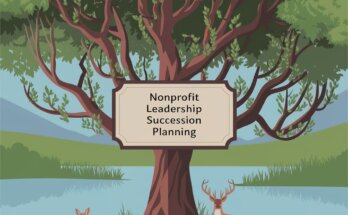Building a strong leadership team in a nonprofit is crucial for the organization’s success and sustainability.
Nonprofits operate in a unique environment that requires a dedicated group of leaders who are not only passionate about the cause but also skilled in various aspects of management, fundraising, and community engagement.
In this blog post, we’ll explore effective strategies to develop a robust leadership team that can drive your nonprofit toward achieving its mission.
1. Define Clear Roles and Responsibilities
One of the first steps in building a strong leadership team is to define clear roles and responsibilities. When team members understand their individual roles, they can work more effectively toward common goals.
For instance, if you have a fundraising manager, their primary responsibility should be to strategize and implement fundraising initiatives. In contrast, a communications director should focus on developing and executing a marketing plan that effectively promotes your nonprofit’s mission.
Example:
Consider a nonprofit focused on providing educational resources to underprivileged children.
The leadership team could consist of a director of programs responsible for curriculum development, a fundraising manager focused on securing grants, and a community outreach coordinator tasked with engaging local schools and families.
Each member should know their responsibilities to prevent overlap and ensure that all aspects of the organization are covered.
2. Foster Open Communication
Open communication is vital for a successful leadership team. When team members feel comfortable sharing their thoughts and ideas, it fosters a culture of collaboration and innovation. Leaders should encourage regular check-ins, team meetings, and feedback sessions to ensure everyone is on the same page.
Example: Implement a weekly team meeting where leaders discuss ongoing projects, challenges, and successes. During these meetings, encourage each member to share updates and insights. This practice not only promotes transparency but also strengthens the team’s bond, allowing them to support each other more effectively.
3. Encourage Diverse Perspectives
Incorporating diverse perspectives within your leadership team can lead to better decision-making and problem-solving.
Diversity brings different viewpoints, experiences, and ideas to the table, which can help your nonprofit innovate and adapt to changing circumstances.
Example: A nonprofit that serves a multicultural community might benefit from having leaders who reflect that diversity. By including individuals from various cultural backgrounds, the organization can better understand and address the unique needs of its constituents.
A Story of Diversity in Leadership
Let’s take a moment to consider the story of a nonprofit organization called “Harmony for All.” This organization was established to promote cultural understanding through arts education. Initially, the leadership team consisted of members from a single demographic, which limited their outreach efforts.
Recognizing this shortfall, the executive director decided to broaden the leadership team. They actively sought out individuals from different cultural backgrounds, including artists, educators, and community leaders. As a result, the organization developed programs that resonated with a wider audience. Their initiatives included multicultural art festivals, language exchange workshops, and outreach programs in various neighborhoods.
This strategic move not only diversified their leadership team, but also significantly increased their community engagement and funding opportunities. Harmony for All became a vibrant hub for cultural exchange, showcasing the power of diverse perspectives in nonprofit leadership.
4. Invest in Leadership Development
To build a strong leadership team, nonprofits must invest in leadership development. This involves providing training and resources to help leaders enhance their skills. Whether it’s workshops, mentorship programs, or online courses, ongoing professional development is essential for fostering growth.
Example: A nonprofit can partner with local universities or training organizations to offer leadership workshops. Topics may include conflict resolution, strategic planning, and effective communication. By equipping leaders with these skills, the organization can ensure they are prepared to tackle challenges and lead their teams effectively.
5. Build Trust Within the Team
Trust is the foundation of any strong leadership team. When team members trust each other, they are more likely to collaborate effectively and support one another during challenging times. Building trust takes time, but is crucial for creating a cohesive team.
Example: Encourage team-building activities that promote bonding and trust. This could be as simple as a team lunch, a retreat, or volunteer activities where leaders work together on a common goal. These experiences can help break down barriers and foster genuine connections among team members.
6. Set Clear Goals and Objectives
A successful leadership team must work toward clear goals and objectives. Establishing measurable targets provides direction and motivation for the team. It also allows leaders to assess progress and make necessary adjustments along the way.
Example: When creating your strategic plan, involve the entire leadership team in the goal-setting process. Each leader should contribute to defining the objectives for their respective areas.
For instance, if one of your goals is to increase fundraising by 20% in the next year, each leader should outline their strategy to achieve this target, whether through grant applications, events, or individual donations.
7. Recognize and Celebrate Achievements
Celebrating achievements, both big and small, can significantly boost morale and motivation within the leadership team. Recognition fosters a positive environment and encourages continued dedication to the organization’s mission.
Example: Implement a monthly recognition program where leaders acknowledge each other’s contributions. This could be as simple as a shout-out during team meetings or a “Leader of the Month” award that highlights individual accomplishments. Celebrating milestones, such as successful fundraising campaigns or community events, can also reinforce the team’s commitment to the organization’s mission.
8. Encourage Innovation and Risk-Taking
Nonprofits often operate in dynamic environments that require innovation and adaptability. Encouraging leaders to take calculated risks and think creatively can lead to new solutions and strategies.
Example: Create an innovation fund that allows team members to propose new ideas or initiatives. If a leader has a concept for a new program or outreach strategy, allocate a small budget to explore it further. This approach not only fosters a culture of innovation but also empowers team members to take ownership of their ideas.
9. Build a Strong Board of Directors
A strong board of directors is essential for effective nonprofit governance. Board members should bring diverse skills, perspectives, and experiences to the table, complementing the leadership team’s strengths.
Example: When recruiting board members, look for individuals with backgrounds in finance, marketing, law, or community development. A well-rounded board can provide valuable guidance, resources, and connections that benefit the leadership team and the organization as a whole.
10. Embrace Feedback and Continuous Improvement
Encouraging a culture of feedback and continuous improvement is vital for a strong leadership team. Leaders should feel comfortable giving and receiving constructive feedback, which can help identify areas for growth and enhance overall performance.
Example: Implement a quarterly feedback session where team members can share their thoughts on team dynamics, processes, and goals. This open dialogue encourages leaders to voice their opinions and fosters an environment of transparency and trust.
Conclusion
Building a strong leadership team in a nonprofit is a continuous journey that requires intentional strategies and dedication.
Are you ready to take your nonprofit leadership to the next level? Subscribe to the Nonprofit Navigators Newsletter for more expert tips and resources to help your organization thrive.
Don’t forget to download our Free, Top 10 Donor Stewardship Strategies for Nonprofits + Free Donor Engagement Checklist, to enhance your fundraising efforts and strengthen donor relationships. Together, we can build a brighter future for the communities we serve!




